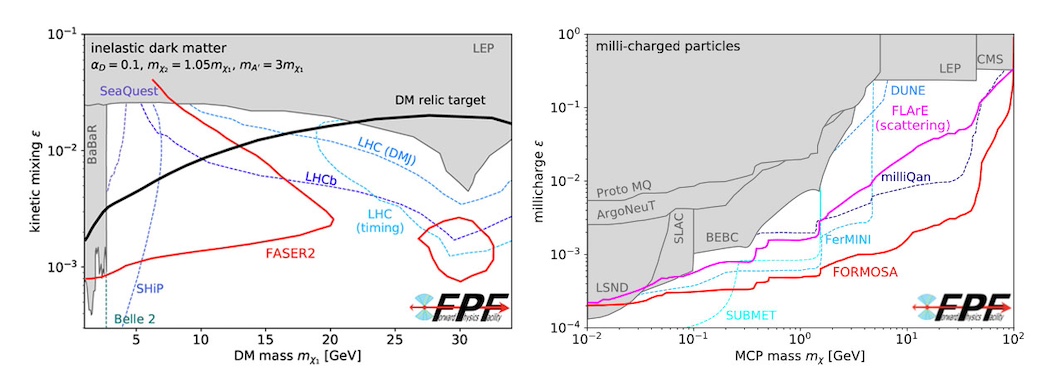While traditional searches for BSM physics at the LHC focus on heavy and relatively strongly interacting states, new particles might also be light, but very weakly interacting. Such light, feebly-interacting particles indeed naturally appear in many models of new physics designed to address the most significant outstanding questions in particle physics, including the nature of dark matter (DM), the electroweak hierarchy problem, the matter-antimatter asymmetry, the origin of neutrino masses, inflation, and the strong CP problem. At the LHC, such particles may be produced abundantly in the forward direction, producing a collimated beam of new particles directed at the FPF.
The FPF BSM program encompasses a broad set of searches for novel signatures that leverage the diverse capabilities of the suite of FPF experiments. These include long-lived-particle decay to a variety of visible final states, DM scattering signatures, and unconventional ionization caused by new particles with fractional electric charge. At the FPF, the precision physics program in high-energy neutrinos will open additional windows on BSM physics by probing their non-standard interactions (NSI) and oscillations into sterile neutrinos.
Two examples are shown in the figure at the bottom of the page. In the left panel, the expected sensitivity of FASER2 to inelastic DM is shown for the example benchmark scenario indicated in the figure. The search is focused on displaced semi-visible decays of highly-boosted excited DM states produced in pp collisions at the LHC. As can be seen, FASER2 will be able to decisively test a broad swath of parameter space where DM is produced in the early universe through thermal freezeout. Notably, the high energies available at the LHC allow for probes of larger dark sector masses than in beam-dump searches, while sensitivity to highly displaced decays leads to a sensitivity reach that is complementary to the existing large-scale LHC detectors.
There are also prospects for millicharged particle (mCP) searches. Such particles provide an interesting BSM physics target, both for their possible implications for the principle of charge quantization and as a candidate for a strongly interacting sub-component of dark matter. FORMOSA, a proposed scintillator-based experiment at the FPF, will have world-leading sensitivity to mCPs. When compared to existing bounds and projections from several other ongoing or proposed experiments, FORMOSA benefits from the high-energy LHC collisions and the enhanced mCP production in the forward region, enabling potentially the most sensitive probe of mCPs in the broad mass range from 100 MeV to 100 GeV.
This small sampling of benchmark studies provides a few examples of the exciting BSM physics opportunities at the FPF, which will greatly expand the existing experimental program of the experiments currently operating at the LHC and elsewhere. The many experimental signatures and large range of BSM particle masses that can be probed at the FPF, from MeV up to even a few hundred GeV, provide the foundation for a broad BSM physics program that will address fundamental questions in particle physics in a manner that is complementary to other existing and proposed facilities.


